Follow these simple tips on how to make the Perfect Poached Egg. With tips and tricks to make your poached egg perfect every time.

I could eat poached eggs for breakfast every day and never get bored, I love them, but they have to be done right and for me that means a running yolk. Don't like a runny yolk? Just cook them for longer!
My favourite way to eat poached eggs? Usually on toast with smoked salmon, avocado and chives. It is pretty much my perfect meal. I also get asked if eggs are bad and how many I eat a day.
Firstly, no, eggs are not bad. The cholesterol that eggs contain has almost no affect on your body. Your cholesterol levels are affected more by saturated and trans fats. So, eat eggs with confidence that your cholesterol won't be affected. Do be aware of what you are eating your eggs with though.
Eggs are awesome! Make sure you always go for good quality free range eggs. And the fresher, the better.
Jump to:
Why make poached eggs?
- Ready in a few minutes
- Only 78 calories in each egg
- A good source of proteins and vitamins (including vitamin D)
- Perfect for breakfast, lunch or dinner
Step by step
Step 1: It is best to use eggs that are room temperature, so remove your eggs from the fridge at least 30 minutes before cooking.
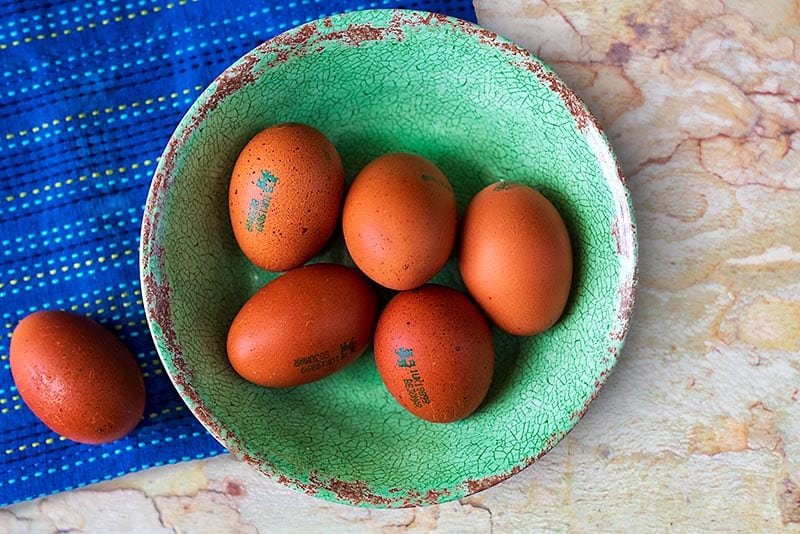
Add a tablespoon of vinegar to a large pan (you can use any vinegar, but I find rice vinegar works best)and add boiling water. Add a generous pinch of sea salt to the water.
The vinegar and salt are the key part to this, as it is the vinegar that keeps the whites together and helps you get a perfect poached egg. You can't taste the vinegar when eating the eggs either.
The salt makes the water more dense, therefore lifting the eggs off the bottom of the pan and prevents them from sticking.
Bring the water back to the boil.
Step 2: Here's the clever bit! Using a spoon, gently place the whole uncracked eggs into the boiling water for 30 seconds each. This will partially boil the outer part of the egg white, making the egg more stable and less likely to spread out when cracked into the water.
If the water isn't deep enough to cover the egg, rotate it over after 15 seconds and boil for another 15 seconds. IMPORTANT: Do not boil the eggs for more than 30 seconds.
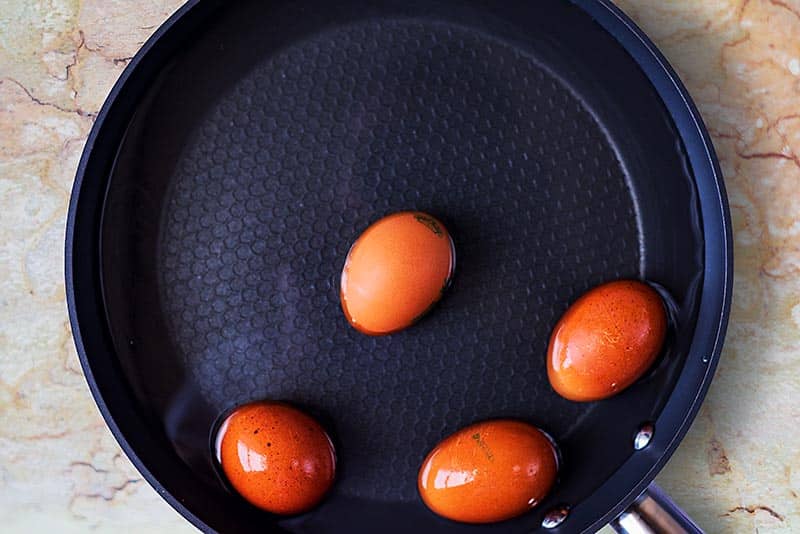
Using a slotted spoon, remove the eggs from the pan and turn the heat down to a gentle simmer.
Step 3: Use a sharp, heavy knife to break the egg shell and gently crack the egg into the simmering water. Hold the egg as close to the surface of the water as you can, without scalding your hands. Open the cracked egg just enough for the yolk to drop out, pulling the white with it.
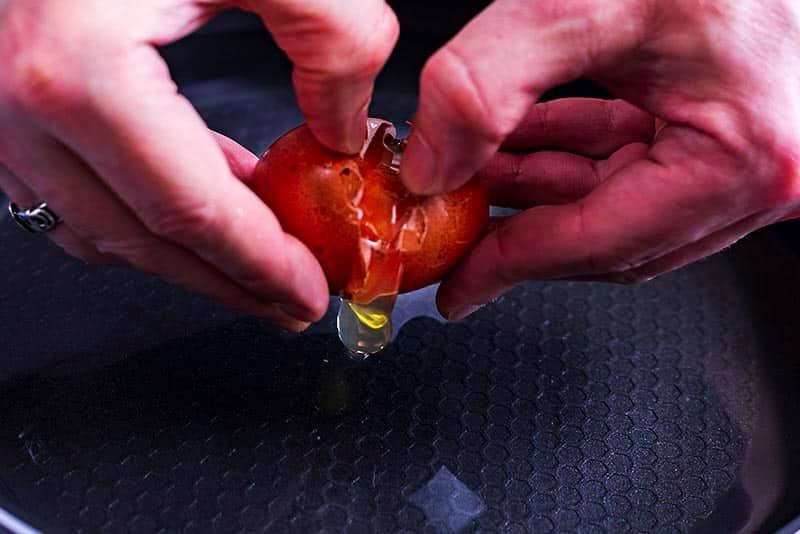
You can also add the egg to a cup or ramekin and gently pour it in, but I have more success with just cracking it in.
Step 4: Cook the eggs on a gentle simmer for 3 minutes. If you want a hard yolk, cook it for 1 minute longer. Turn the heat off but leave the eggs in the water for an additional minute.
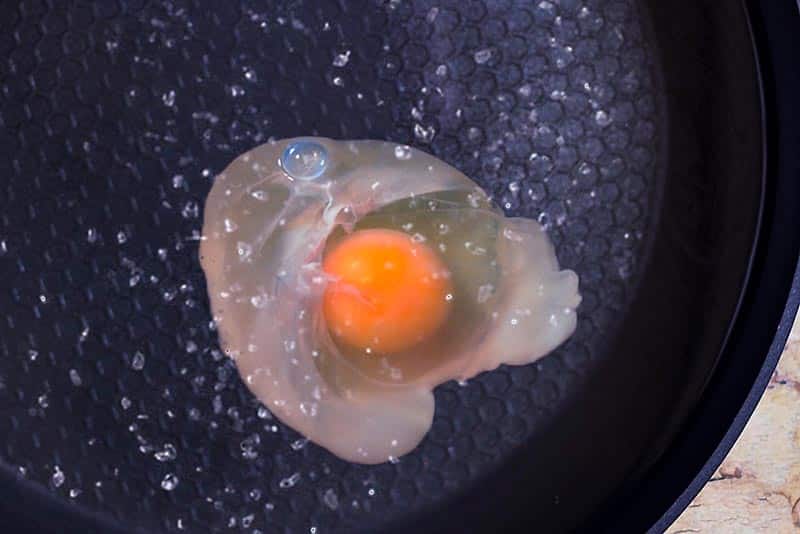
Step 5: Use a flat, slotted spatula to remove the eggs from the pan and place them on kitchen paper. This will absorb any water from the egg, meaning you won't get soggy toast!
Next, hold the edge of the spatula next to the egg and using the edge of the kitchen paper, gently flip the egg onto the spatula so it is upside down. Use your finger to gently press the underneath of the yolk to test if it is cooked to your liking. If not, return to the water for another 30-60 seconds.
What eggs to use
The fresher, the better. Fresh eggs hold together better and they also taste better. With eggs, you do get what you pay for, so make sure you use a good quality, free-range egg.
Sieve method
The method used in this how-to uses a pre-boiling technique. Instead of this, if you have a very fine mesh sieve, crack the eggs into the mesh over a bowl to remove the thinner egg white. The thicker white will remain around the egg, where you can then transfer the egg to another bowl or straight into the pan to cook. However, you need to be extremely careful with the sieve method as the yolks can easily break.
What to serve poached eggs with
Poached eggs are delicious just on some simple buttered toast with a pinch of salt and pepper. Maybe add some hot sauce for a little kick of heat. To take it further, why not add some smashed avocado to the toast? Maybe some smoked salmon? Or some wilted spinach.
Here are some other things that you can add a poached egg to:
- They are great in a bacon sandwich
- Add one to a burger
- Put one on top of a pizza
- Top a salad with a poached egg
- Make a simple spaghetti dish using our easy pasta sauce and top with a poached egg
- Shakshuka is a way of poaching eggs in a spicy tomato sauce - great for breakfast, lunch or dinner
- Huevos Rancheros - a traditional Mexican breakfast that can use poach or fried egg
- Top a comforting stew with a poached egg
- Add it to the top of Nasi Goreng (Indonesian Fried Rice) instead of the traditional omelette.
FAQs
Yes you can. If you are preparing poached eggs in advance, make sure you have a large bowl of iced water ready. Once the eggs are cooked to your liking, remove from the pan and transfer to the iced water. This will stop the cooking process immediately and keep them just right. You can keep them like this in the fridge for 3-4 days. To reheat, put some hot water in a bowl and put the eggs in it for 20-30 seconds, until warmed through.
More egg recipes
If you’ve tried this perfect poached egg recipe, let us know how you got on in the comments below.
Tag us in your creations on Instagram @hungryhealthyhappy - Use the hashtag #hungryhealthyhappy too.
Recipe
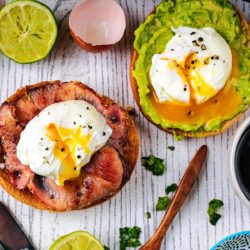
How To Make The Perfect Poached Egg
Ingredients
- 4 Eggs - (free range are best)
- Water - boiled
- 1 tablespoon Vinegar - (rice vinegar is best)
- Sea salt
Instructions
- It is best to use eggs that are room temperature, so remove your eggs from the fridge at least 30 minutes before cooking.
- Add a tablespoon of vinegar to a large pan (you can use any vinegar, but I find rice vinegar works best) and add boiling water. Add a generous pinch of sea salt to the water.The vinegar and salt are the key part to this, as it is the vinegar that keeps the whites together and helps you get a perfect poached egg. You can't taste the vinegar when eating the eggs either. The salt makes the water more dense, therefore lifting the eggs off the bottom of the pan and prevents them from sticking.
- Bring the water back to the boil.
- Here's the clever bit! Using a spoon, gently place the whole uncracked eggs into the boiling water for 30 seconds each. This will partially boil the outer part of the egg white, making the egg more stable and less likely to spread out when cracked into the water.If the water isn't deep enough to cover the egg, rotate it over after 15 seconds and boil for another 15 seconds. IMPORTANT: Do not boil the eggs for more than 30 seconds.Using a slotted spoon, remove the eggs from the pan and turn the heat down to a gentle simmer.
- Use a sharp, heavy knife to break the egg shell and gently crack the egg into the simmering water. Hold the egg as close to the surface of the water as you can, without scalding your hands. Open the cracked egg just enough for the yolk to drop out, pulling the white with it.You can also add the egg to a cup or ramekin and gently pour it in, but I have more success with just cracking it in.
- Cook the eggs on a gentle simmer for 3 minutes. If you want a hard yolk, cook it for 1 minute longer. Turn the heat off but leave the eggs in the water for an additional minute.
- Use a flat, slotted spatula to remove the eggs from the pan and place them on kitchen paper. This will absorb any water from the egg, meaning you won't get soggy toast!
- Next, hold the edge of the spatula next to the egg and using the edge of the kitchen paper, gently flip the egg onto the spatula so it is upside down. Use your finger to gently press the yolk to test if it is cooked to your liking. If not, return to the water for another 30-60 seconds.
- Serve on top of smoked salmon, avocado or both on toast.
Nutritional Information
The nutritional information provided is approximate and is calculated using online tools. Information can vary depending on various factors, but we have endeavoured to be as accurate as possible.
As all appliances vary, cooking times are a guide. Please note that by changing the serving size, the cooking time may also need to be altered.



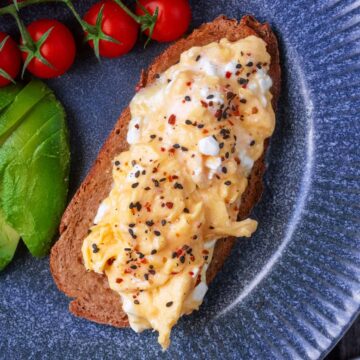

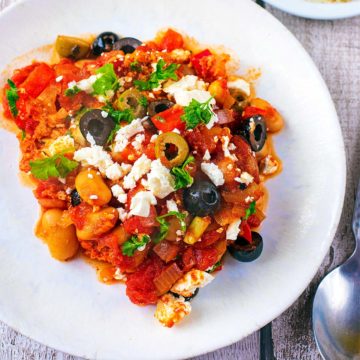
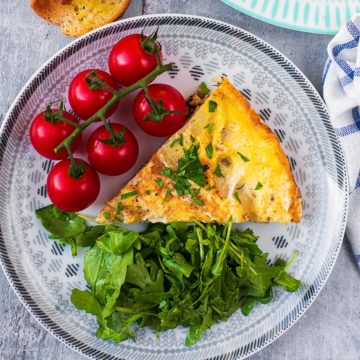
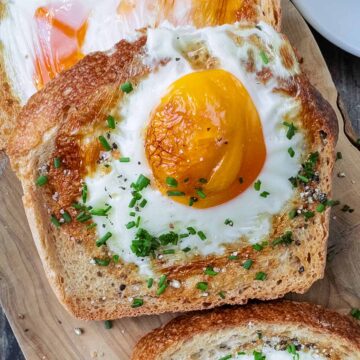

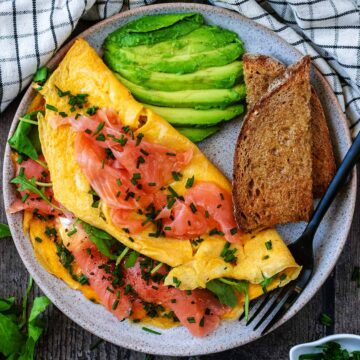
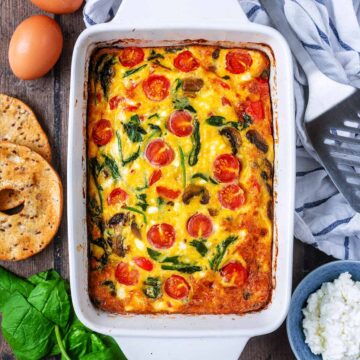
Elizabeth says
Your poached eggs do always look so perfect. Especially the yolk.
Dannii says
Thank you! I pride myself on a perfect poached egg.
Kerry says
I would love some more How To guides for other things, like chopping and other cooking techniques. I am not a very good cook at all, but I would love to learn and I like how you explain things in a simple way. Just thought I would suggest it :)
Dannii says
Thanks for the suggestion :) It is a feature I have actually thought about doing, so I will start putting some ideas together.
Heather Haigh says
Great guide - I always wondered what the vinegar was for - now I'm dying to know the science behind how it works but I guess from the point of view of a good poached egg - if it works, it works.
Dannii says
The acidic environment acts on the albumin in the egg white to solidify it. You can use lemon juice too.
Katy says
Yum! Great photo. I love eggs every kind of way. They are a super food IMHO.
Dannii says
Thanks :) They really are a super food.
Cat says
I love poached eggs but I've never been able to perfect them! I even bought a special pan but they turn them into really awful McDonald-esque shapes ;) I've heard the fresher the eggs the better too.
Dannii says
I get that shape when I make them in a muffin tin in the oven, but I prefer doing them in the pan. Yes, the fresher the better!
Jayne Fielding says
Great tutorial. I read about the vinegar tip a few years ago and was sceptical, but it works!
Dannii says
It is amazing that something so simple can help.
Laura says
Poached eggs and avocado is my favourite way to eat eggs. The combination is yummy.
Dannii says
Avocado on anything is delicious :)
Amy says
Ooh I love poached eggs, and this is a great guide! They're good for you and help get your brain going, too!
Amy x
Dannii says
Definitely brain food!
Carly says
I could eat that up right now. Thanks for sharing how you get them to look so perfect.
Dannii says
Sorry, I ate it all first :D
Catherine Culmer says
My hubby makes the like this - I like the simple way. I use a glass jug and the microwave
Cat
http://www.rockandrollpussycat.co.uk
Dannii says
I haven't done them in the microwave before.
Nadine says
Thank you! I love poached eggs and always order them when we go out for breakfast, but I just can't seem to get them right myself. I have never heard about using vinegar, so hopefully that will help :)
Dannii says
Give it a try and come back and let us know how you got on.
Yvonne says
You need to come and make me breakfast Dannii, this looks incredible.
Dannii says
Maybe I should start a breakfast delivery service haha
Annabeth says
That DOES look like the perfect breakfast. I love some poached eggs, but I "cheat" and use the holders.
Dannii says
I have never been able to get them to "set" that way.
Tiffany says
I saw you post this advice on Instagram a couple of months ago and I have been making them this was ever since and it really goes make a difference. I also find that if the pan is too big (for just making a couple of eggs), the whites tend to spread. So I use a small pan if just making them for myself.
Dannii says
I am glad that my tip helped :)
Sue says
Who knew that vinegar was the secret ingredient! Thanks for the tip Dannii.
Dannii says
Not so secret now ;)
Michelle says
I love poached eggs and many years ago my grandmother taught me the vinegar trick. I could eat them every day! Runny yolks for me too, please. Love them with feta cheese and sautéed spinach.
Dannii says
It has to be a runny yolk. Oh, and everything is better with feta!